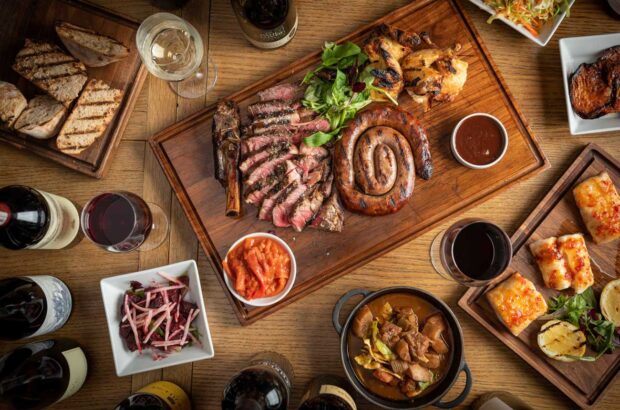The extreme southeastern tip of this island is home to some of Italy's most exquisite food, as well as the classic Marsala wine. Carla Capalbo is your gastronomic guide
SIESTA time – la pausa – is almost over. It’s been too hot to do anything but withdraw to the cool of a darkened room and wait for the Sicilian summer’s sun to abate. The town of Ragusa is beginning to stir: the church bell has sounded five times and I can hear the high-pitched cry of the fruit and vegetable vendor as his old van works its way up the steep hill: ‘i pumaroli… ‘i piri… ‘i cipuddi.’ He stops outside. Doors in the narrow street open and close as the old women come out with their baskets to buy his freshly-picked produce. Just yesterday I was given a bunch of little green and red pears from Etna tied together by their long stems with a string. They were crunchy and so sweet, so quintessentially pear-like in their flavour, that they reminded me again of what makes food in Sicily so unique. The sun, salt winds and lack of water on the island intensify everything, burning off excesses, reducing size but concentrating taste into an explosion of sweetness and perfume.
The Sicilian summer has been dry; it hasn’t rained hard here for two years. The Iblean Mountains, rounded, cream-coloured hills covered with an intricate network of ancient dry-stone walls, are a parched ochre colour. Even the cattle, immobile now from the heat, blend into this monochromatic landscape that is punctuated only by the deep green of the carob trees. The cows’ milk is made into a local cheese, Caciocavallo Ragusano DOP, which is pressed into large rectangular blocks and matured by hanging from ropes.
https://www.decanter.com/premium/discover-sicily-20-great-buys-406634/
Sensory overload
I have been rereading The Leopard, Giuseppe di Lampedusa’s brilliant novel, much of which is set in an imaginary Castello di Donnafugata in this very landscape, in what he describes as ‘the archaic and aromatic countryside’. He continues, ‘The term “countryside” implies soil transformed by labour; but the scrub clinging to the slopes was still in the very same state of scented tangle in which it had been found by Phoenicians, Dorians and Ionians when they disembarked in Sicily, that America of antiquity.’
The real Donnafugata Castle, located between Ragusa and the sea, is an elegant 19th-century construction of eclectic styles. It has recently been restored and opened to the public. Its gardens reflect the personal eccentricities of the baron who built it, with a metaphysical stone-wall maze and waterworks hidden in bushes for drenching unsuspecting guests.
I venture out into the chiaroscuro of the late afternoon. It’s the hour of la passeggiata – the ritual evening promenade – and the streets are filling up with shoppers and conversationalists, stopping at bars for a drink and a smoke. I drop into Pasticceria Di Pasquale, a sleek place in the upper town centre, for a glass of COS’ fine Cerasuolo di Vittoria DOC – Frappato and Nero d’Avola – which is made near here. Only then do I feel ready to start the breathtakingly beautiful walk down, then up again, to Ragusa Ibla.
Ragusa is a double-centred city, built on twin hills linked, for cars, by steep winding roads and, for walkers, by steeper staircases that are woven into the fabric of the buildings like three-dimensional snakes and ladders. Ragusa Ibla is at the heart of baroque Sicily, because when rebuilding began after the devastating earthquake of 1693, the baroque style was in its golden age, so the area’s key towns – Noto, Modica, Scicli, Ragusa and Vittoria – were conceived and reconstructed like variations on a single theme. Within 20 years of the earthquake, 200 churches had been erected.
I love Ragusa Ibla, with its stage-like central piazza which slopes down and away from the monumental Duomo of San Giorgio; its exterior, like much of Noto, designed by the architect Rosario Gagliardi. The narrow streets around it are full of hidden gems: tiny squares, a pretty park and, for my money, one of the most talented chefs in Italy.
At Ristorante Duomo, Ciccio Sultano has launched an inspired cucina from his intimate dining rooms in what was once a private house behind the church. His is a Sicilian cuisine of the senses, of the pure flavours that can speak of a territory, of a landscape, of the complexity and simplicity of the culture of the island. With a true palate, he seeks out what’s best in Sicily – the sweetest fruits, the most balanced cheeses, the freshest fish, the most characterful nuts and the most aromatic herbs – and works with them to keep their identities and perfumes intact.
‘When a very flavourful ingredient is cooked carefully just before you eat it, it loses none of its natural fragrance,’ explains the engaging 32-year-old, a native of Vittoria who, unbelievably, received no formal training in the kitchen. ‘Modern Sicilian cooking bridges the gap between the past and the future. My inspiration has been the memory of the way food used to taste here.’ Sultano lightly smokes sea bream over lavender and carob wood, then matches it with a tartare of mackerel and a fresh sauce of pounded Noto almonds. A fine purée of local chickpeas is topped with a just-cooked terrine of wild red mullet and tenerumi leaves – the narrow Sicilian gourd that hints of spice and can grow to one metre in length. The dish goes well with nearby Gulfi’s white Caricanti, made from indigenous Carricante and Albanello grapes. For dessert, the classic cannolo Siciliano – sweetened ewes’ ricotta in a fried pastry shell – is surprisingly deconstructed. Sultano’s partner, Angelo di Stefano, has assembled an impressive list of Sicilian and Italian wines to accompany the food, so treat yourself to the island’s best gastronomic experience.
Twenty minutes’ drive from Ragusa, Modica is also built on steep slopes; the road that now divides them was once a river. The panorama of pale houses and churches packed together in a seemingly impossible agglomerate is astonishing. Even the culture is stacked: just below the house where Nobel-winning poet, Salvatore Quasimodo, was born is a tiny Byzantine church dug right out of the rock – la chiesetta rupestre. It was uncovered 15 years ago by accident, having been used as a storage cellar, its vibrant, layered frescoes painted over with lime.
Fierce flavours
Food lovers should not miss the Antica Dolceria Bonajuto, a marvellous pastry shop in the heart of town. Franco Ruta and his family bake great traditional pastries, but they are best known for their aromatic, granular-textured chocolate made, as the Aztecs did, without overly heating the cocoa mass. It comes flavoured with vanilla, cinnamon or fiery chilli peppers. Before heading west I want to go to Noto to stock up on Corrado Assenza’s honeys scented with wild local herbs and spices. His Caffè Sicilia also offers delicious cakes using vegetables instead of fruit. Just nearby I can have a granita of lemons or mandarins made by maestro gelataio Corrado Costanzo, who is carrying on an ice cream tradition that was begun by the Arabs one thousand years ago using snow and infusions of jasmine and rose petals. Then I’ll drive the interminable B-road along the south coast to Marsala.
Tangy sea air
The most beautiful place to watch a Sicilian sunset is overlooking the salt flats near Marsala, up the coast towards Trapani. It’s a magical, watery world halfway between sea and land. Have a drink at the bar by the Saline Infersa and watch the sky’s colours change as they are reflected in the salt pans of different densities. ‘Taking the best, mineral-rich salts from the sea and leaving the impurities behind is an ancient art,’ explains Giacomo D’Ali Staiti, who has restored a handsome 16th century windmill here and created a salt museum.
https://www.decanter.com/features/sicily-hot-stuff-247764/
‘It involves pumping sea water through a series of shallow, insulated fields whose salinity increases under the hot summer sun until salt crystals form. The salt is then gathered into “pyramids”.’ At the end of the season, these large mounds are protected from the autumn rains, which would otherwise wash the salt right back into the sea, by terracotta tiles.
For dinner I treat myself to a plate of busiati – pasta that has been hand-rolled around a reed stalk to give it a spiral form. At Ristorante Eubes, beside the Saline, it is dressed with chunks of fresh tuna and with the intensely aromatic capers of Pantelleria that are preserved sotto sale, in sea salt.
Marsala’s historic centre is charming and unspoiled. ‘Old Marsala is neatly contained within a walled square with fortified gates that was formalised during the Renaissance,’ explains Sandro Tarantino from the town’s comune. ‘But its origins go back much farther, to the 4th century BC, when the Phoenicians founded it.’ The city-port thrived under the Romans and Saracens and even now there is a Moorish feel to its narrow, lively streets. The daily ‘Spanish’ market is one of Sicily’s best, with great atmosphere and a colourful show of weird and wonderful sea creatures.
This town is really all about its wine and its history has been linked to Britain since the end of the 18th century, when it was discovered by trader John Woodhouse. He realised that the local oxidised wine, fortified with brandy, kept well on long sea voyages, and he did good business selling it to Admiral Nelson’s navy. If you have time to visit just two of the Marsala wineries, I recommend Florio, for a look at an impeccable historic cellar, and Marco de Bartoli, whose Samperi estate gives a good idea of what a family-run Sicilian cantina is like.
De Bartoli can be credited with bringing Marsala’s wine from the brink of bad taste, when eggs, fruits and allsorts were being added to it, back to the forefront of Italy’s dessert wines, as his marvellous Vecchio Samperi testifies.







